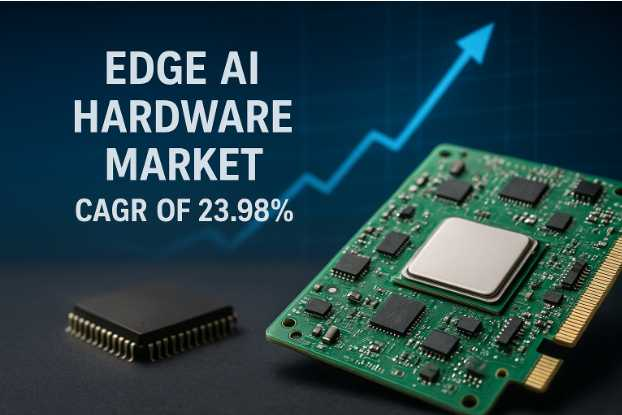Edge AI Hardware Market: Powering the Future of Intelligent Devices
In the ever-evolving world of technology, Edge AI hardware is becoming the cornerstone of next-generation intelligent systems. From smart cameras and autonomous vehicles to wearable devices and industrial robots, the integration of artificial intelligence at the network’s edge is transforming how data is processed, analyzed, and acted upon. Unlike traditional AI systems that rely heavily on cloud infrastructure, edge AI brings computational power closer to the source of data, enabling faster decision-making and enhanced privacy. As industries continue to adopt automation, IoT, and smart analytics, the Edge AI Hardware Market is witnessing exponential growth driven by advancements in chip design, energy efficiency, and AI algorithms.
Edge AI Hardware Market Size and Growth Outlook
According to the SNS Insider, The Edge AI Hardware Market Size was valued at USD 23.32 Billion in 2024 and is projected to reach USD 130.18 Billion by 2032, growing at a remarkable CAGR of 23.98% over the forecast period from 2025 to 2032. This extraordinary growth reflects the rising demand for low-latency processing, real-time analytics, and secure data management at the device level. With organizations shifting focus toward decentralized computing, edge AI hardware such as processors, GPUs, and ASICs are gaining traction for their ability to perform inference locally without relying on cloud networks. The growing use of 5G technology, coupled with an increase in IoT-connected devices, is further fueling the market’s momentum worldwide.
Edge AI Hardware Market Drivers: Enabling Real-Time Intelligence
One of the main drivers of the Edge AI Hardware Market is the surging demand for real-time decision-making across industries. Businesses are increasingly deploying AI models at the edge to process data faster, minimize latency, and enhance user experiences. The integration of AI into devices like smartphones, drones, and autonomous vehicles is enabling smarter, safer, and more efficient operations. Moreover, the ongoing advancements in semiconductor technology—particularly the miniaturization of AI chips—are making it feasible to embed AI processing capabilities in smaller, energy-efficient devices.
Additionally, the growing adoption of edge computing in healthcare, retail, and manufacturing is playing a vital role in market expansion. For instance, smart medical devices that analyze patient data in real time or predictive maintenance systems that detect equipment failures before they occur are practical applications powered by edge AI hardware.
Edge AI Hardware Market Challenges: Managing Cost and Power Efficiency
Despite its rapid growth, the Edge AI Hardware Market faces a few key challenges. One of the most pressing issues is balancing performance with energy efficiency. Since edge devices often operate in low-power environments, manufacturers must design chips that deliver high computational output without consuming excessive energy. Another challenge is the high initial cost associated with developing and deploying edge AI hardware infrastructure, which can limit adoption among small and medium enterprises.
Furthermore, ensuring interoperability and security in edge environments remains a complex task. As devices become increasingly interconnected, maintaining data integrity and privacy at the edge is critical to preventing vulnerabilities and cyber threats.
Edge AI Hardware Market Opportunities: Expanding with 5G and IoT Growth
The Edge AI Hardware Market presents immense opportunities with the expansion of 5G networks and the rapid proliferation of IoT devices. The combination of AI and 5G is revolutionizing industries such as automotive, telecommunications, and manufacturing by enabling ultra-fast data transmission and intelligent automation. As 5G networks continue to roll out globally, the deployment of edge devices equipped with AI capabilities is expected to accelerate dramatically.
In addition, the increasing trend toward smart cities and connected infrastructure will generate new revenue streams for hardware manufacturers. Governments and enterprises are investing heavily in IoT-driven ecosystems, where edge AI plays a crucial role in traffic management, energy optimization, and public safety. The integration of AI chips into consumer electronics and industrial automation systems further underscores the vast potential of this market.
Regional Analysis: North America Leads, Asia-Pacific Accelerates
Geographically, North America dominates the Edge AI Hardware Market due to its strong technological infrastructure, early adoption of AI technologies, and presence of key players such as NVIDIA, Intel, and Qualcomm. The region’s growing investments in autonomous vehicles, robotics, and advanced computing systems are propelling demand for high-performance AI chips.
Meanwhile, the Asia-Pacific region is emerging as the fastest-growing market, driven by rapid digital transformation, the expansion of smart manufacturing, and increasing smartphone penetration. Countries like China, Japan, South Korea, and India are investing significantly in AI-driven innovations, fostering a robust ecosystem for hardware production and deployment. Europe also holds a substantial market share, supported by government initiatives promoting AI adoption across industrial and healthcare sectors.
Future Trends in the Edge AI Hardware Market
Looking ahead, the Edge AI Hardware Market is set to undergo major transformations with the integration of advanced AI architectures such as neuromorphic computing and quantum AI chips. These technologies aim to mimic the human brain’s neural structure, offering faster processing with minimal power consumption. The adoption of federated learning—where AI models are trained locally on edge devices without sharing raw data—will further strengthen privacy and data security.
Moreover, partnerships between hardware manufacturers, AI software developers, and cloud service providers are expected to drive innovation, enabling seamless AI deployment across hybrid edge-cloud ecosystems. As a result, the market will continue to expand, reshaping industries and redefining how machines perceive and interact with the world.
FAQs about the Edge AI Hardware Market
Q1. What is the CAGR of the Edge AI Hardware Market during 2025–2032?
The Edge AI Hardware Market is projected to grow at a CAGR of 23.98% between 2025 and 2032, driven by increasing demand for real-time processing, IoT expansion, and 5G network integration.
Q2. What is the forecasted market size of the Edge AI Hardware Market by 2032?
The market is expected to reach USD 130.18 Billion by 2032, showcasing significant growth from its 2024 valuation of USD 23.32 Billion.
Q3. Which region is expected to experience the fastest growth in the Edge AI Hardware Market?
The Asia-Pacific region is anticipated to witness the fastest growth due to rising investments in smart technologies, large-scale manufacturing capabilities, and the rapid adoption of AI-enabled devices across key industries.




















